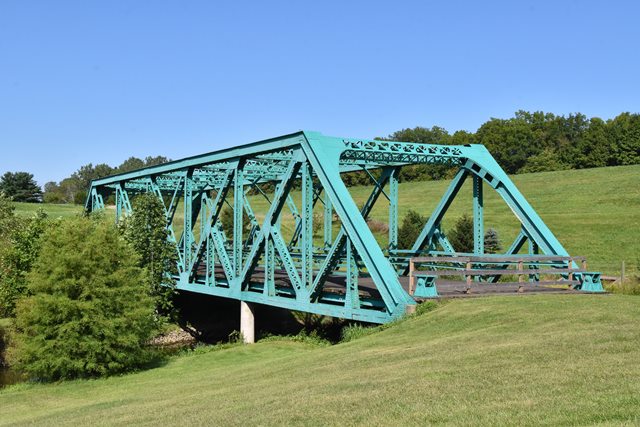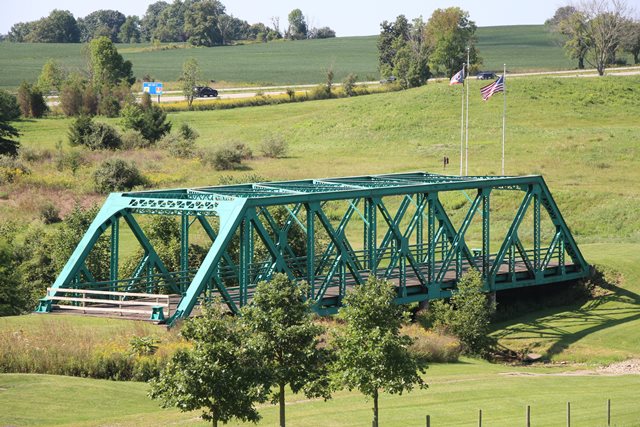We Recommend:
Bach Steel - Experts at historic truss bridge restoration.
BridgeHunter.com Phase 1 is released to the public! - Visit Now
Buffalo Creek Retreat Bridge
Hubbard Valley Park Bridge

Primary Photographer(s): Nathan Holth and Rick McOmber
Bridge Documented: August 24, 2019 and September 6, 2021
Rural: Medina County, Ohio: United States
2004
151.0 Feet (46 Meters)
151.0 Feet (46 Meters)
24 Feet (7.32 Meters)
1 Main Span(s)
52XXXX1

View Information About HSR Ratings
Bridge Documentation
This heavy duty through truss was moved and preserved here ca. 2004 and is a rare example of a highway Baltimore truss in Ohio. The previous location was on OH-269 over railroad in Erie County (41.49833, -82.83333). In its current location the bridge has supplemental bents added under the truss.
Information and Findings From Ohio's Historic Bridge InventorySetting/Context The bridge carries a pathway over a stream in a park setting at the Hubbard Valley Park (Cross Creek Retreat). Physical Description The 1 span, 151'-long, Baltimore thru truss bridge is traditionally composed of built-up compression members. Integrity Relocated and rehabilitated for bike trail use ca. 2004. Original location was SR 269 over Conrail in Danbury in Erie County (2204177). Removed in 1993 and in storage in Erie County until relocated to Medina, ca. 2004. Summary of Significance The 1927 thru truss was determined eligible in 1990.
It remained in storage for nearly a decade before being relocated and
rehabilitated for use in a park in Medina County. Although relocated,
the bridge has retained the original character defining features of the
Baltimore truss pattern, with its subdivided panels. It is a
technologically late example of a type/design that was developed in the
1870s, but it is a rare type in the state highway context, with only
three examples identified dating from 1923 to 1930 (Phase 1A, 2008). Justification The bridge is one of three extant highway examples of the design that is also well represented for railroad bridges. It is of moderate significance. Bridge Considered Historic By Survey: Yes |
This bridge is tagged with the following special condition(s): Unorganized Photos
![]()
Photo Galleries and Videos: Buffalo Creek Retreat Bridge
Bridge Photo-Documentation
Original / Full Size PhotosA collection of overview and detail photos. This gallery offers photos in the highest available resolution and file size in a touch-friendly popup viewer.
Alternatively, Browse Without Using Viewer
![]()
Bridge Photo-Documentation
Mobile Optimized PhotosA collection of overview and detail photos. This gallery features data-friendly, fast-loading photos in a touch-friendly popup viewer.
Alternatively, Browse Without Using Viewer
![]()
Additional Unorganized Photos
Original / Full Size PhotosA supplemental collection of photos that are from additional visit(s) to the bridge and have not been organized or captioned. This gallery offers photos in the highest available resolution and file size in a touch-friendly popup viewer.
Alternatively, Browse Without Using Viewer
![]()
Additional Unorganized Photos
Mobile Optimized PhotosA supplemental collection of photos that are from additional visit(s) to the bridge and have not been organized or captioned. This gallery features data-friendly, fast-loading photos in a touch-friendly popup viewer.
Alternatively, Browse Without Using Viewer
![]()
Maps and Links: Buffalo Creek Retreat Bridge
Coordinates (Latitude, Longitude):
Search For Additional Bridge Listings:
Bridgehunter.com: View listed bridges within 0.5 miles (0.8 kilometers) of this bridge.
Bridgehunter.com: View listed bridges within 10 miles (16 kilometers) of this bridge.
Additional Maps:
Google Streetview (If Available)
GeoHack (Additional Links and Coordinates)
Apple Maps (Via DuckDuckGo Search)
Apple Maps (Apple devices only)
Android: Open Location In Your Map or GPS App
Flickr Gallery (Find Nearby Photos)
Wikimedia Commons (Find Nearby Photos)
Directions Via Sygic For Android
Directions Via Sygic For iOS and Android Dolphin Browser
USGS National Map (United States Only)
Historical USGS Topo Maps (United States Only)
Historic Aerials (United States Only)
CalTopo Maps (United States Only)


